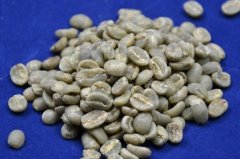[literacy] have you made a clear distinction between the coffee bean grading criteria? (below)
There are different ways to manage the origin of coffee beans, some are composed of large and small farmers, some are dominated by professional business owners, even if the coffee in the same place, its quality and flavor are also different, in order to mark the quality of coffee, but also in order to make the transaction more convenient, so there is a "coffee classification."
Highly graded by place of origin:
Central American countries such as Guatemala, Costa Rica and El Salvador are all located in high and undulating mountains, and the coffee farms in the country are all located in mountains of different heights, so it is necessary to grade coffee beans according to the level of origin.
Generally speaking, the height of the producing area is relatively low, the climate is relatively warm, the coffee grows faster, the density of raw beans is smaller, the texture is not hard, and the quality of coffee is relatively poor, while the climate in alpine areas is cold and the growth rate of coffee is slow. the density of raw beans is high, the texture is hard, and the coffee is naturally fragrant and sour. So there are also people who grade according to "hardness". The grading of these areas can be divided into the following categories, and only the first few can be included in the selection of coffee.
Some farms are located on gentle slopes along the Pacific coast, with a height of between 984ft and 3280ft, known as "Pacific class" and with low acidity. Similarly, in places such as Mexico, Honduras and Haiti, the selection of coffee should be rated as Strictly High Grown (extremely high mountain beans, referred to as SHG), followed by High Grown (high mountain beans, referred to as HG).
The grading method of Hawaiian Kona coffee:
Hawaiian Kona Coffee is mainly divided into Type1 and Type2, with several grades at the bottom. Type1 refers to plain beans, while Type2 belongs to Pea-Berry.
Due to the excellent handling of Kona coffee, the following grades can be included in the selection of coffee.
Type1
Konatou (Kona Extra Fancy)
Size of beans: diameter greater than or equal to 19cm 64 inches
Moisture content: 9% to 12%
Defective beans: less than 10
Kona Special Bean (Kona Fancy)
Size of beans: diameter greater than or equal to 18cm 64 inches
Moisture content: 9% to 12%
Defective beans: less than 16
Acceptable first-grade bean (Kona Number One)
Size of beans: diameter greater than or equal to 16cm 64 inches
Moisture content: 9% to 12%
Defective beans: less than 20
Ke Na high grade bean (Kona Prime Pea-Berry)
Size of beans: diameter greater than or equal to 10cm 64 inches
Moisture content: 9% to 12%
Defective beans: no more than 25% by weight. Among them, the weight of fermented beans and black beans should not exceed 5% of the total weight.
The grading of Yemeni coffee:
The grading method developed by the anarchy in Yemen has been negotiated by organizations in recent years, and the country's newspapers and media are strongly calling for a result in the near future.
Classification of Ethiopian coffee:
Ethiopia's grading system began in 1952 and was revised in 1954. The country classifies raw coffee beans into one to five grades (Grade1~5), which are graded by the Ethiopian Coffee Commission (NCBE).
First, the second level reserved water to wash beans, sun-dried beans from the third and fourth levels began to grade down. The first level is rarely seen, and the secondary beans on the market are basically the best washed beans. It should be noted that, in fact, many exporters will lower the grade of coffee beans by one notch because of taxes and fees, for example, from Grade 3 sun beans to Grade 4. Therefore, the general second-level Yejiaxuefei and Sidamo water-washed beans are already good products, while the fourth-level Yejiaxuefei and Sidamo sun-dried beans are also good products.
Classification of Indian coffee:
India is the sixth largest coffee producer in the world, and its coffee grading method is different from that of other countries. It is necessary to distinguish between Arabica and Robusta beans, and then classify these two kinds of beans according to the size of raw beans. In the case of Arabica, the water-washed bean crown is named Plantation (large farm or joint processing center), and the grades are classified as A-Magi B, unwashed C, BBB, and Bulk, while the naturally dried bean (unwashed) is crowned with Cherry, as shown below:
As far as robusta beans are concerned, water-washed beans are crowned with Parchment, followed by AB,C,BBB and Bulk. The naturally dried beans are crowned with Cherry, as shown below:
The average Parchment-AB is 15 beans (15,64 inches), but there is also a more accurate classification. Some people pick more than 17 beans (17paddle 64 inches) and call them Kaapi Royale, which is a good recipe for selected espresso beans or general beans.
Classification of Colombian coffee:
Colombian coffee is divided into three levels, such as Supremo,Excelso,Extra, of which Supremo is the highest, Extra is the last, and Excelso here is a mixture of the first two to meet the needs of commercial coffee buyers.
The fast-growing coffee tree is already growing in most parts of Colombia, targeting the high-end commercial coffee market, but even the highest-grade coffee beans are not necessarily delicious. However, the "Supremo 18" selected from Supremo has a good flavor and can be found in boutique coffee stores.
Finally, when it comes to the grading of coffee beans, what we have to mention is the grading method of the American Fine Coffee Association. We all know that SCAA has established a grading method and a poster. Their classification method is also divided into several grades according to the number of defective beans, the first level is "boutique", and the counting method of defective beans has many similarities with the former. This classification method can sometimes be seen because some imported coffee beans are treated in US warehouses to promote the US market.
Important Notice :
前街咖啡 FrontStreet Coffee has moved to new addredd:
FrontStreet Coffee Address: 315,Donghua East Road,GuangZhou
Tel:020 38364473
- Prev

Kenya AA completely washed coffee beans washed coffee beans
English name: Kenya AA English name: Kenya AA Commodity Specification: 227g Coffee country: Kenyan Coffee Grade: AA treatment: complete washing treatment roasting degree: medium and Deep roasting (Full City +) / second burst first break intensive Coffee Industry all think that Kenya kenya AA coffee is one of its favorite products, because Kenya kenya AA coffee bag
- Next

The skill of coffee flower drawing, the technique of foam waltz, the technique of milking.
There are two main types of Latte Art: Free Pour, which draws patterns while pouring hot milk into espresso, and Etching, which, after mixing the latte, is carved directly on the foam on the latte surface with accessories such as chocolate sauce and toothpicks. Compared with carving, the former is more wonderful, while the latter
Related
- What is the meaning of lactic acid fermentation with coffee bean treatment?
- How to judge the state of foam by sound?
- How does the latte pull out the unicorn pattern? Come to get for a little trick to improve the flower pull!
- Will flower pulling affect the taste of the latte?
- Do you know the history of coffee?
- The difference between honey treatment and sun washing what is raisin honey treatment?
- What kind of milk can a novice use to make coffee foam to keep the foam longer? The correct method and skills of milking tutorial sharing
- Why do washed coffee beans taste sour? Flavor characteristics of washed Coffee
- Introduction to the skill of how to practice the size and height of water injection around the circle of hand-brewed coffee
- How do beginners practice coffee flower drawing from scratch?

